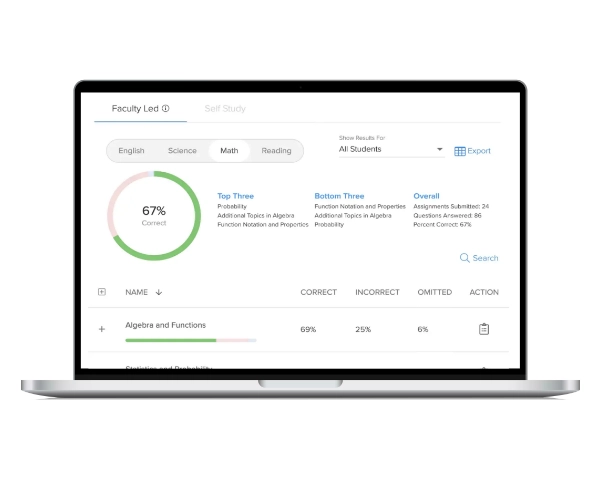As teachers, we’ve all found ourselves stuck in a professional development session with an overly-zealous presenter. You try to remind yourself that it’s just 30 more minutes until lunch, when you can finally leave with your co-workers and buy your Applebee’s in peace. You start to sweat when you see the presenter pull out anchor chart paper and markers, and as if in slow-motion, you hear her explain how you’re going to do a “brain dump exit ticket” for the king of all educational buzzwords: differentiation. It’s a word frequently thrown around in education, yet rarely understood. It’s the buzzword everyone loves to hate, because although everyone knows “it’s what’s best for the kids,” very few people know how to do it in a way that’s both effective and realistic.
What is Differentiated Instruction in Education?
There are many ways differentiation has been defined in education over the years, so for the sake of authenticity, we’ll look at its original source. Dr. Carol Ann Tomlinson is credited for coining the term “differentiated instruction,” and describes it as tailoring instruction to meet individual [student] needs.
At its core, differentiation isn’t controversial. On the contrary, it’s been a core part of best teaching practices for decades, and there aren’t too many teachers who would argue against academically meeting their students where they currently are. The stigma that goes along with DI typically centers around certain misconceptions that surround the term and the idea that true differentiation isn’t possible. In addition to this, some AP teachers also foster the idea that differentiation isn’t needed in higher-level courses.
Some of the most common misconceptions about differentiated instruction strategies for AP include the beliefs that:
- It doesn’t properly prepare students for college, as college professors do not differentiate their instruction.
- Students in AP classes don’t need differentiation because DI is really only meant for learning gaps and students who struggle with academics.
- Planning for DI can take up a lot of time and require a variety of resources.
- AP tests are standardized, so differentiated exam prep is unrealistic.
Before we address what DI isn’t, we first need to look beyond its basic definition and talk about what it is.
What are the 3 elements of differentiated instruction?
On a fundamental level, differentiation in education consists of three specific elements:
- It focuses on student-centered teaching and learning
- It recognizes the different learning needs each student has
- It applies multiple teaching strategies to meet the needs of all students
These are all excellent attributes for high-quality instruction in general, but how does that justify the need for differentiation in the AP classroom?
Why Is Differentiated Instruction Important in the AP Classroom?
To answer this question, let’s first address the misconceptions about differentiated AP instruction that were listed earlier.
Perceived Drawbacks of Using Differentiated Instruction in AP
Myth: It doesn’t properly prepare students for college, as college professors do not differentiate their instruction.
- As a result of technology and a better understanding of how authentic learning is achieved, many of the top colleges in the United States are beginning to promote differentiated instruction strategies.
Myth: Students in AP classes don’t need differentiation because DI is really only meant for learning gaps and students who struggle with academics.
- Even in AP courses, students have individual academic needs, areas of struggle, and learning preferences. In addition to this, open enrollment has paved the way for students who are English language learners, as well as students with disabilities, like dyslexia. These students require instructional differentiation, as well as the consideration of learning preferences.
Myth: Planning for DI can take up a lot of time and resources, and it’s unrealistic with standardized testing.
- This is partially true. DI does require time and resources, but technology has made it much easier to plan for differentiation without having to spend a lot of extra time or money on resources to do so. And yes, standardized tests–like AP exams–are given to students in the same format, regardless of their learning preferences. That being said, data gathered from standardized testing practice can help teachers identify learning gaps that can allow them to differentiate instruction for their AP students and fill in any information they will need to be successful.
- Collecting data from assessments can save teachers time and money. For example, an AP teacher can use the data reports provided in UWorld’s Learning Tools for AP Courses and sort students into different groups based on their misunderstanding of certain concepts. The teacher can rotate working with these specific groups, and while other students are waiting, they can work on UWorld questions their instructor has assigned to them based on their group’s academic needs.
Benefits of Using Differentiated Instruction in AP
The benefits of differentiating instruction in the AP classroom are much the same as DI in any learning environment:
Student-Centered
This might seem like a given, but throughout most of public education’s existence, instruction was more lecture-based rather than centered on student involvement and inquiry. With differentiated instruction, students are no longer passive learners, and lessons are based on student engagement.
Strives for Equity
When instruction focuses on meeting the individual needs of each student, the result is that every student will have a genuine chance at academic progress. “Leveling the playing field” for AP success is true equitable learning.
Acknowledges Difference
Historically, education focused on providing students with one way to learn and the exact same opportunities to succeed. Some students would “get it,” and others would not. DI, however, acknowledges that all students are different and have varying strengths, weaknesses, and learning preferences.
Increases Engagement
When the individual needs of students are being met, they are significantly more likely to remain engaged with their learning. On the other hand, when student struggles are not addressed, they are significantly more likely to “check out” of the learning process.
Increasingly Possible with Tech & AI
One of the benefits of having “tech-forward” classes is the ability to quickly gauge a student’s strengths and weaknesses from online assessment data, such as the data provided in reports from UWorld’s Learning Tools for AP Courses. Teachers can then use this data to easily differentiate instruction for their students.
How to Incorporate Differentiated Instruction into Your AP Classroom
In general, there are four basic ways AP teachers can apply differentiation in their classrooms:
Varying the Content
This usually involves an element of student choice that allows them to decide on a specific aspect of an assignment or topic.
Varying the Learning Process
Teachers who vary their instructional learning processes “mix up” their lessons by providing students with a variety of learning modalities. Students who prefer visual learning may study a detailed diagram of a topic, whereas students who prefer to read may prefer to read detailed paragraphs explaining a topic.
Varying the Assessment
Although certain aspects of standardized AP testing cannot be varied, there are specific accommodations granted to students who have disabilities that require a 504 plan. In addition to this, everyday formative assessments can be varied in a multitude of ways. Teachers can gauge a student’s understanding of concepts by allowing them to demonstrate their learning with essays, presentations, visual representations, and demonstrations.
Varying the Classroom Environment
Some students have physical and/or emotional needs that are best met with consideration of the classroom environment itself. This may involve an adjustment in the classroom layout, fidget devices, or planned activity breaks.
Varying the Content
This usually involves an element of student choice that allows them to decide on a specific aspect of an assignment or topic.
Differentiated Instruction Example
“An AP English Literature and Composition teacher may give their students an assignment that requires them to analyze a specific kind of poetic genre. To incorporate an element of choice, the teacher may allow students to choose the poem they wish to analyze, so long as it fits within the assigned genre.”
Varying the Learning Process
Teachers who vary their instructional learning processes “mix up” their lessons by providing students with a variety of learning modalities. Students who prefer visual learning may study a detailed diagram of a topic, whereas students who prefer to read may prefer to read detailed paragraphs explaining a topic.
Differentiated Instruction Example
“An AP Environmental Science teacher may assign their students several questions about the Nitrogen Cycle in UWorld’s Learning Tools for AP Courses. When an incorrect answer is chosen, a student with visual learning preferences may focus on the illustrated diagram within the answer explanation, whereas a student who prefers to study notes on a topic may focus on the detailed written description within the answer explanation.”
Varying the Assessment
Although certain aspects of standardized AP testing cannot be varied, there are specific accommodations granted to students who have disabilities that require a 504 plan. In addition to this, everyday formative assessments can be varied in a multitude of ways. Teachers can gauge a student’s understanding of concepts by allowing them to demonstrate their learning with essays, presentations, visual representations, and demonstrations.
Differentiated Instruction Example
“Students who have a 504 plan for a documented disability may qualify for a variety of accommodations, such as extended time, large-print exams, a written copy of spoken test instructions, or permission to use a braille device, computer, or magnifying device.”
Varying the Classroom Environment
Some students have physical and/or emotional needs that are best met with consideration of the classroom environment itself. This may involve an adjustment in the classroom layout, fidget devices, or planned activity breaks.
Differentiated Instruction Example
“A student with ADHD may find it easier to focus on a lesson if they are allowed the use of a small fidget cube.”
“An AP English Literature and Composition teacher may give their students an assignment that requires them to analyze a specific kind of poetic genre. To incorporate an element of choice, the teacher may allow students to choose the poem they wish to analyze, so long as it fits within the assigned genre.”
“An AP Environmental Science teacher may assign their students several questions about the Nitrogen Cycle in UWorld’s Learning Tools for AP Courses. When an incorrect answer is chosen, a student with visual learning preferences may focus on the illustrated diagram within the answer explanation, whereas a student who prefers to study notes on a topic may focus on the detailed written description within the answer explanation.”
“Students who have a 504 plan for a documented disability may qualify for a variety of accommodations, such as extended time, large-print exams, a written copy of spoken test instructions, or permission to use a braille device, computer, or magnifying device.”
“A student with ADHD may find it easier to focus on a lesson if they are allowed the use of a small fidget cube.”
Getting Started With Differentiation in an AP Classroom
There is no such thing as perfect differentiated instruction strategies, and the truth is that as much as teachers strive to meet their students where they are, they can only accomplish this by meeting themselves where they are. Scaffolding is important for educator growth just as much as it is for students, so adding differentiation into your instructional practices little by little will make a world of difference.
The next time you assign an article on a topic, try giving them a video link, too. For your next project assignment, try giving your students an element of choice in either the topic or how they present their knowledge on it. If you have a student who is an English language learner in your class, remember to give them additional time to respond to a question. All of these little changes will reap great rewards for each student’s ability to succeed.
How UWorld Learning Tools for AP can help you make your students college ready?
At UWorld, our exam-like questions offer explanations that differentiate for students with diverse learning preferences, such as detailed illustrations for visual learners, and embedded tools that support students with different needs. Our Learning Tools for AP Courses are designed to meet students where they are and help them succeed.




